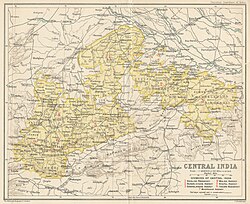History
In 1344, the city of Uchchakalpa, present-day Unchahara, was founded by Raja Veerraj Judeo when he seized the fort of Naro from "the others". In 1720 the state was renamed Nagod after its new capital. In 1807 Nagod was a tributary to Panna and was included in the sanad granted to that state. In 1809, however, Lal Sheoraj Singh was recognized and confirmed in his territory by a separate sanad granted to him. Nagod State became a British protectorate after the treaty of Bassein in 1820. Raja Balbhadra Singh was deposed in 1831 for murdering his brother. The state fell into debt and in 1844 the administration was taken over by the British owing to economic mismanagement. The ruler was loyal during the Indian Mutiny in 1857 and was granted the pargana of Dhanwahl. In 1862 the Raja was granted a sanad allowing adoption and in 1865 local rule was reestablished. Nagod State was a part of Baghelkhand Agency [2] from 1871 till 1931, when it was transferred along with other smaller states back to Bundelkhand Agency. The last Raja of Nagod, HH Shrimant Mahendra Singh, signed the accession of his state to the Indian Union on 1 January 1950. [3]
This page is based on this
Wikipedia article Text is available under the
CC BY-SA 4.0 license; additional terms may apply.
Images, videos and audio are available under their respective licenses.

